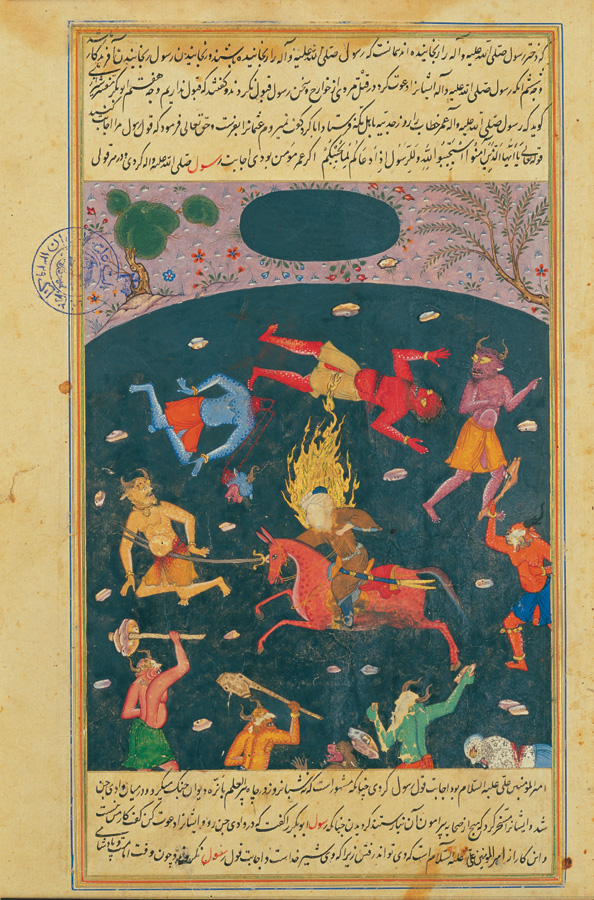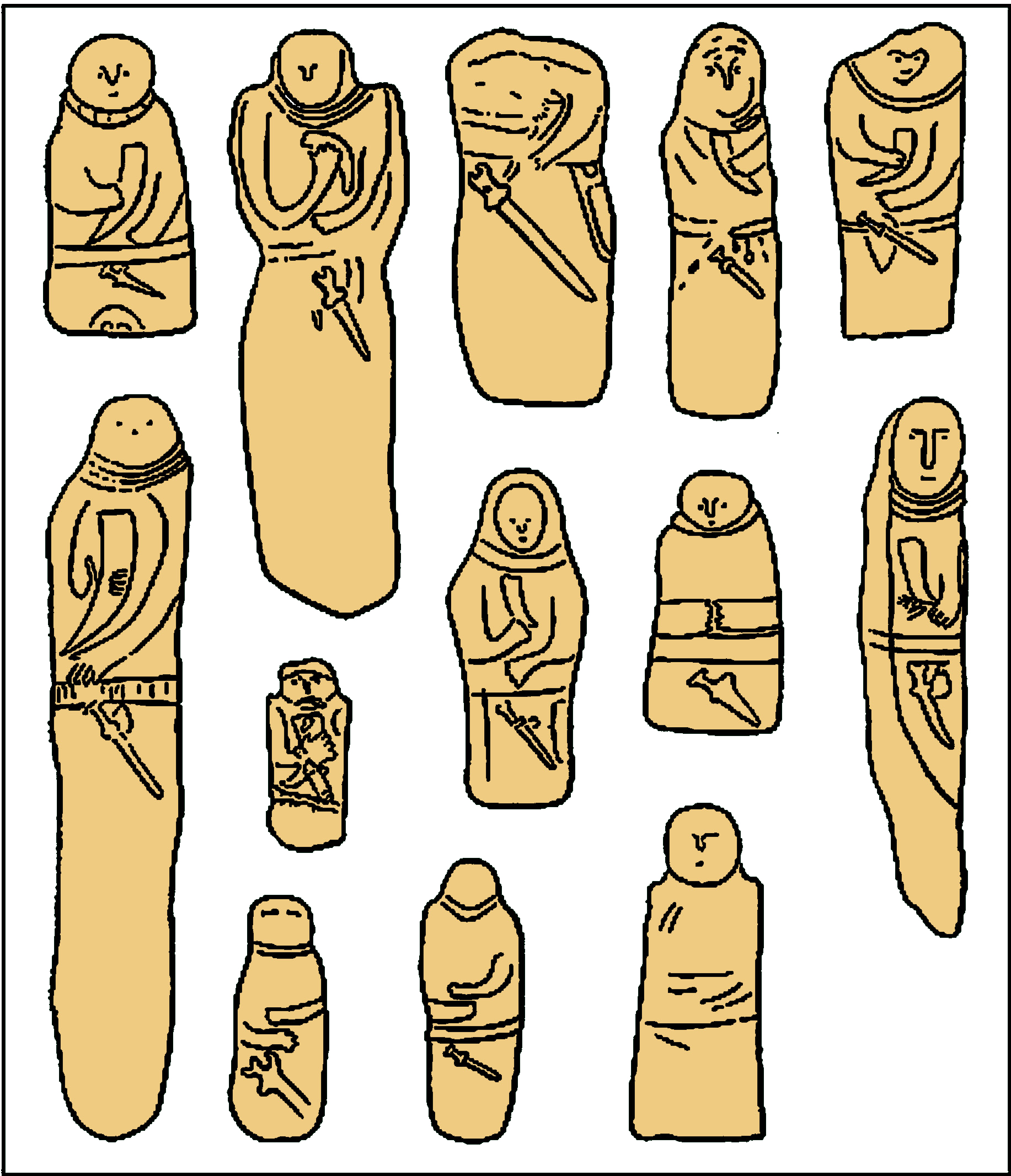|
Daeva
A daeva (Avestan: 𐬛𐬀𐬉𐬎𐬎𐬀 ''daēuua'') is a Zoroastrian supernatural entity with disagreeable characteristics. In the Gathas, the oldest texts of the Zoroastrian canon, the ''daeva''s are "gods that are (to be) rejected". This meaning is – subject to interpretation – perhaps also evident in the Old Persian "''daiva'' inscription" of the 5th century BCE. In the ''Younger Avesta'', the ''daeva''s are divinities that promote chaos and disorder. In later tradition and folklore, the ''dēw''s (Zoroastrian Middle Persian; New Persian ''div''s) are personifications of every imaginable evil. Over time, the Daeva myth as Div became integrated to Islam. ''Daeva'', the Iranian language term, shares the same origin of "Deva" of Hinduism. While the word for the Vedic spirits and the word for the Zoroastrian entities are etymologically related, their function and thematic development is altogether different. Originally, the term was used to denote beings of cultural folk ... [...More Info...] [...Related Items...] OR: [Wikipedia] [Google] [Baidu] |
Div (mythology)
Div or dev ( Persian: ': ) (with the broader meaning of demons or fiends) are monstrous creatures within Middle Eastern lore. Most of their depictions derive from Persian mythology, integrated to Islam and spread to surrounding cultures including Armenia, Turkic countries and Albania. Although they are not explicitly mentioned within canonical Islamic scriptures, their existence was well accepted by most Muslims just like that of other supernatural creatures. They exist along with jinn, ''peri'' (fairies) and '' shayatin'' (devils) within South- and Central Asia demon-beliefs. They are described as having a body like that of a human, only of gigantic size, with two horns upon their heads and teeth like the tusks of a boar. Powerful, cruel and cold-hearted, they have a particular relish for the taste of human flesh. Some use only primitive weapons, such as stones: others, more sophisticated, are equipped like warriors, wearing armour and using weapons of metal. Despite their unc ... [...More Info...] [...Related Items...] OR: [Wikipedia] [Google] [Baidu] |
Zoroastrianism
Zoroastrianism is an Iranian religion and one of the world's oldest organized faiths, based on the teachings of the Iranian-speaking prophet Zoroaster. It has a dualistic cosmology of good and evil within the framework of a monotheistic ontology and an eschatology which predicts the ultimate conquest of evil by good. Zoroastrianism exalts an uncreated and benevolent deity of wisdom known as '' Ahura Mazda'' () as its supreme being. Historically, the unique features of Zoroastrianism, such as its monotheism, messianism, belief in free will and judgement after death, conception of heaven, hell, angels, and demons, among other concepts, may have influenced other religious and philosophical systems, including the Abrahamic religions and Gnosticism, Northern Buddhism, and Greek philosophy. With possible roots dating back to the 2nd millennium BCE, Zoroastrianism enters recorded history around the middle of the 6th century BCE. It served as the state religion of the ... [...More Info...] [...Related Items...] OR: [Wikipedia] [Google] [Baidu] |
Deva (Hinduism)
''Deva'' (; Sanskrit: , ) means "shiny", "exalted", "heavenly being", "divine being", "anything of excellence", and is also one of the Sanskrit terms used to indicate a deity in Hinduism.Monier Monier-Williams, A Sanskrit-English Dictionary” Etymologically and Philologically Arranged to cognate Indo-European Languages, Motilal Banarsidass, page 492 ''Deva'' is a masculine term; the feminine equivalent is '' Devi''. In the earliest Vedic literature, all supernatural beings are called ''Devas''George Williams (2008), A Handbook of Hindu Mythology, Oxford University Press, , pages 90, 112 and '' Asuras''. The concepts and legends evolved in ancient Indian literature, and by the late Vedic period, benevolent supernatural beings are referred to as ''Deva-Asuras''. In post-Vedic Hindu texts, such as the Puranas and the Itihasas of Hinduism, the ''Devas'' represent the good, and the ''Asuras'' the bad. In some medieval works of Indian literature, ''Devas'' are also referred ... [...More Info...] [...Related Items...] OR: [Wikipedia] [Google] [Baidu] |
Avestan
Avestan (), or historically Zend, is an umbrella term for two Old Iranian languages: Old Avestan (spoken in the 2nd millennium BCE) and Younger Avestan (spoken in the 1st millennium BCE). They are known only from their conjoined use as the scriptural language of Zoroastrianism, and the Avesta likewise serves as their namesake. Both are early Eastern Iranian languages within the Indo-Iranian language branch of the Indo-European language family. Its immediate ancestor was the Proto-Iranian language, a sister language to the Proto-Indo-Aryan language, with both having developed from the earlier Proto-Indo-Iranian language; as such, Old Avestan is quite close in both grammar and lexicon to Vedic Sanskrit, the oldest preserved Indo-Aryan language. The Avestan text corpus was composed in the ancient Iranian satrapies of Arachosia, Aria, Bactria, and Margiana, corresponding to the entirety of present-day Afghanistan as well as parts of Tajikistan, Turkmenistan, and Uzbekistan. T ... [...More Info...] [...Related Items...] OR: [Wikipedia] [Google] [Baidu] |
Greater Iran
Greater Iran ( fa, ایران بزرگ, translit=Irān-e Bozorg) refers to a region covering parts of Western Asia, Central Asia, South Asia, Xinjiang, and the Caucasus, where both Iranian culture and Iranian languages have had a significant presence and impact. Historically, this was a region long-ruled by the dynasties of various Iranian empires, under whose rule the local populace incorporated considerable aspects of Persian culture through extensive inter-contact, or alternatively where sufficient Iranian peoples settled to still maintain communities who patronize their respective cultures; it roughly corresponds geographically to the Iranian plateau and its bordering plains. The Encyclopædia Iranica uses the term ''Iranian Cultural Continent'' to describe this region. In addition to the modern state of Iran, the term "Greater Iran" includes all of the territory ruled by various Iranian peoples throughout history, including in Mesopotamia, the eastern half ... [...More Info...] [...Related Items...] OR: [Wikipedia] [Google] [Baidu] |
In Comparison With Vedic Usage
IN, In or in may refer to: Places * India (country code IN) * Indiana, United States (postal code IN) * Ingolstadt, Germany (license plate code IN) * In, Russia, a town in the Jewish Autonomous Oblast Businesses and organizations * Independent Network, a UK-based political association * Indiana Northeastern Railroad (Association of American Railroads reporting mark) * Indian Navy, a part of the India military * Infantry, the branch of a military force that fights on foot * IN Groupe , the producer of French official documents * MAT Macedonian Airlines (IATA designator IN) * Nam Air (IATA designator IN) Science and technology * .in, the internet top-level domain of India * Inch (in), a unit of length * Indium, symbol In, a chemical element * Intelligent Network, a telecommunication network standard * Intra-nasal (insufflation), a method of administrating some medications and vaccines * Integrase, a retroviral enzyme Other uses * ''In'' (album), by the Outsiders, 1967 * In ... [...More Info...] [...Related Items...] OR: [Wikipedia] [Google] [Baidu] |
Indo-Aryan Languages
The Indo-Aryan languages (or sometimes Indic languages) are a branch of the Indo-Iranian languages in the Indo-European language family. As of the early 21st century, they have more than 800 million speakers, primarily concentrated in India, Pakistan, Bangladesh, Nepal, Sri Lanka, and Maldives. Moreover, apart from the Indian subcontinent, large immigrant and expatriate Indo-Aryan–speaking communities live in Northwestern Europe, Western Asia, North America, the Caribbean, Southeast Africa, Polynesia and Australia, along with several million speakers of Romani languages primarily concentrated in Southeastern Europe. There are over 200 known Indo-Aryan languages. Modern Indo-Aryan languages descend from Old Indo-Aryan languages such as early Vedic Sanskrit, through Middle Indo-Aryan languages (or Prakrits). The largest such languages in terms of first-speakers are Hindi–Urdu (),Standard Hindi first language: 260.3 million (2001), as second language: 120 million ... [...More Info...] [...Related Items...] OR: [Wikipedia] [Google] [Baidu] |
Vedic Sanskrit
Vedic Sanskrit was an ancient language of the Indo-Aryan subgroup of the Indo-European language family. It is attested in the Vedas and related literature compiled over the period of the mid- 2nd to mid-1st millennium BCE. It was orally preserved, predating the advent of writing by several centuries. Extensive ancient literature in the Vedic Sanskrit language has survived into the modern era, and this has been a major source of information for reconstructing Proto-Indo-European and Proto-Indo-Iranian history. In the pre-historic era, Proto-Indo-Iranian split into Proto-Iranian and Proto-Indo-Aryan and the two languages evolved independently of each other. History Prehistoric derivation The separation of Proto-Indo-Iranian language into Proto-Iranian and Proto-Indo-Aryan is estimated, on linguistic grounds, to have occurred around or before 1800 BCE. The date of composition of the oldest hymns of the Rigveda is vague at best, generally estimated to roughly 1500 BCE. Both ... [...More Info...] [...Related Items...] OR: [Wikipedia] [Google] [Baidu] |
Proto-Indo-European Language
Proto-Indo-European (PIE) is the reconstructed common ancestor of the Indo-European language family. Its proposed features have been derived by linguistic reconstruction from documented Indo-European languages. No direct record of Proto-Indo-European exists. Far more work has gone into reconstructing PIE than any other proto-language, and it is the best understood of all proto-languages of its age. The majority of linguistic work during the 19th century was devoted to the reconstruction of PIE or its daughter languages, and many of the modern techniques of linguistic reconstruction (such as the comparative method) were developed as a result. PIE is hypothesized to have been spoken as a single language from 4500 BC to 2500 BC during the Late Neolithic to Early Bronze Age, though estimates vary by more than a thousand years. According to the prevailing Kurgan hypothesis, the proto-Indo-European homeland, original homeland of the Proto-Indo-Europeans may have been in th ... [...More Info...] [...Related Items...] OR: [Wikipedia] [Google] [Baidu] |
Scythian Religion
The Scythian religion refers to the mythology, ritual practices and beliefs of the Scythian cultures, a collection of closely related ancient Iranian peoples who inhabited Central Asia and the Pontic–Caspian steppe in Eastern Europe throughout Classical Antiquity, spoke the Scythian language (itself a member of the Eastern Iranian language family), and which included the Scythians proper, the Cimmerians, the Sarmatians, the Alans, the Sindi, the Massagetae and the Saka. The Scythian religion is assumed to have been related to the earlier Proto-Indo-Iranian religion as well as to contemporary Eastern Iranian and Ossetian traditions, and to have influenced later Slavic, Hungarian and Turkic mythologies. Development The Scythian religion was of Iranian origin. The religion was influenced by that of the populations whom the Scythians had conquered, such as the sedentary Thracian populations of the western Pontic steppe. Due to this, many of the Scythian male deities ... [...More Info...] [...Related Items...] OR: [Wikipedia] [Google] [Baidu] |
William Thomas Beckford
William Thomas Beckford (29 September 1760 – 2 May 1844) was an English novelist, art collector, patron of decorative art, critic, travel writer, plantation owner and for some time politician. He was reputed at one stage to be England's richest commoner. The son of William Beckford and Maria Hamilton, daughter of the Hon. George Hamilton, he served as a Member of Parliament for Wells in 1784–1790 and Hindon in 1790–1795 and 1806–1820. Beckford is remembered for a Gothic novel '' Vathek'' (1786), for building the lost Fonthill Abbey in Wiltshire and Lansdown Tower ("Beckford's Tower") in Bath, and for his art collection. Biography Beckford was born in the family's London home at 22 Soho Square on 29 September 1760. At the age of ten, he inherited a fortune from his father William Beckford, who had been twice a Lord Mayor of London. It consisted of £1 million in cash, an estate at Fonthill in Wiltshire (including the Palladian mansion Fonthill Splendens), sev ... [...More Info...] [...Related Items...] OR: [Wikipedia] [Google] [Baidu] |


_p012_BAKU%2C_FIRE_TEMPLE_(cropped).jpg)
.jpg)





